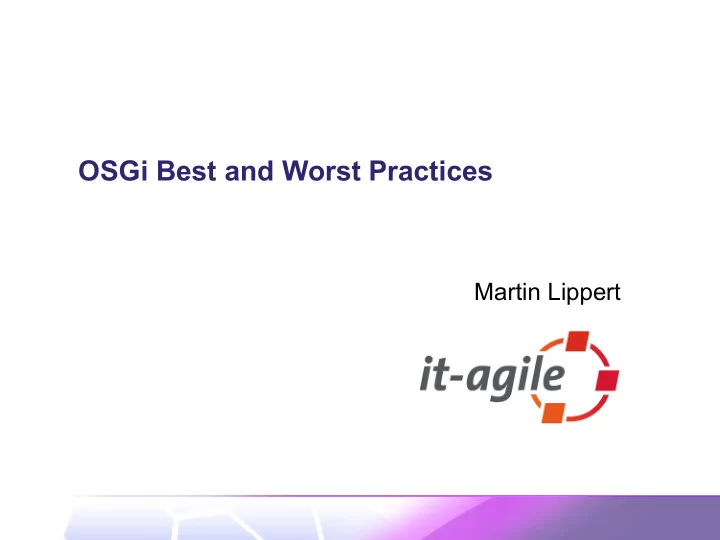

OSGi Best and Worst Practices Martin Lippert
Context • Client apps using: Swing, Hibernate, JDO, JDBC, JNI, SOAP, a lot of Apache stuff, JUnit, FIT, Spring DM, Jetty, CICS-Adaptor, … • Server apps using: JDO, Hibernate, SOAP, REST, Tomcat, Spring DM, CICS- Adaptor, HTTP, a lot of custom libs, Memcached • Eclipse platforms and frameworks including: Equinox, IDE, RCP, p2 and various RT projects • Educating and mentoring people in the real world
Don’t program OSGi
Program your application • Use POJO • Keep your business logic clean • Programming practices to make gluing easy • Dependency injection to allow composition • Separation of concerns • Benefits Delay packaging decisions Increased deployment flexibility
Solutions composed of POJOs • Bundle POJOs as needed • Glue together using Use Declarative Services iPOJO BluePrint Services GuicePeaberry … • Use insulating layers to keep OSGi out of your code
Structure matters
Dependencies Managing dependencies within large systems is one of the most critical success factors for healthy object-oriented business applications
What kind of dependencies? • Dependencies between: Individual classes and interfaces Packages Subsystems/Modules • Dependencies of what kind? Uses Inherits Implements
Don’t shoot the messenger Module Factory OSGi Around here our policy is to shot the messenger!
“Low coupling, high cohesion” Not just a nice idea OSGi makes you think about dependencies It does not create them!
Observations when using OSGi • Design flaws and structural problems often have a limited scope Problems remain within single bundles No wide-spreading flaws
Take just what you need
Import-Package vs. Require-Bundle • Require-Bundle Imports all packages of the bundle, including re-exported bundle packages • Import-Package Import just the package you need
What does it mean? • Require-Bundle Defines a dependency on the producer Broad scope of visibility • Import-Package Defines a dependency on what you need Doesn't matter where it comes from!
When to use what? • Prefer using Import-Package Lighter coupling between bundles Less visibilities Eases refactoring • Require-Bundle only when necessary: Higher coupling between bundles Use only for very specific situations: split packages
Version management • Version number management is essential • Depending on a random version is pointless • Failing to manage version numbers undermines consumers • Import-Package package version management • Require-Bundle bundle version management
Keep Things Private
API • API is a contract with between producer and consumer Prerequisites Function Consequences Durability • Key to effective modularity
Bundle API • What should you export from a bundle? • The easy way: Blindly export everything • That is a really bad idea: No contract was defined Consumers have no guidance Broad visibility High coupling between components
Producers: Think about your APIs • Export only what consumers need Less is more Think about the API of a component API design is not easy • Don’t export anything until there is a good reason for it Its cheap to change non-API code Its expensive to change API code
Consumers: Think about what you’re doing • Stay in bounds • If you can’t do something, perhaps Use a different component Use the component differently Work with the producer to cover your use-case
Informed Consent
Composing
Structuring Bundles Just having bundles is not enough You still need an architectural view You still need additional structures
Your Bundles shouldn't end up like this Go! Get some structure!
Guidelines • Bundle rules in the small Separate UI and core Separate client and server and common Separate service implementations and interfaces Isolate backend connectors • Bundle rules in the mid-size Access to resources via services only Access to backend systems via services only Technology-free domain model
Guidelines • Bundle rules in the large Separate between domain features Separate between applications / deliverables Separate between platform and app-specific bundles • Don’t be afraid of having a large number of bundles Mylyn Working Sets Platforms
Dynamics
Dynamics are hard Its hard to build a really dynamic system, you need to change your mindset Think about dependencies Think about services Think about everything as of being dynamic
Dynamics are hard It’s even harder to turn a static system into a dynamic one
Integration
Integration is easy Integrating an OSGi system into an existing environment is easy OSGi runtimes are easy to start and to embed Clear separation between inside and outside world
Experiences • Integrate existing rich client app into proprietary client container Ugly boot-classpath additions like XML parser stuff Self-implemented extension model using classloaders in a strange way Used a large number of libs that where not necessarily compatible with the existing rich client app • Integration went smoothly just launch your OSGi framework and you are (mostly) done
Integration can be hard • Using existing libraries can be hard Sometimes they do strange classloader stuff Start to love ClassNotFoundException, it will be your best friend for some time • The Context-Classloader hell Some libs are using context-classloader OSGi has no meaning for context-classloader Arbitrary problems
Experiences • We got every (!) library we wanted to use to work within our OSGi environment Rich-client on top of Equinox Server-app on Equinox Server-app embedded into Tomcat and Jetty using Servlet- Bridge • But it can cause some headaches at the beginning
Conclusions
Looking back • Large OO systems grow over years • Its easy and fast to add/change features • OSGi is a major reason… • But why?
OSGi leds us to… • Thinking about structure all the time Avoids mistakes early (before the ugly beast grows) Less and defined dependencies No broken windows • Good separation of concerns • Dependency injection & pluggable architecture Easy to add features without changing existing parts • Many small frameworks Better than few overall ones
Conclusions Never without OSGi You will love it You will hate it
In the end its your best friend
Thank you for your attention Martin Lippert: martin.lippert@it-agile.de Special thanks to Jeff McAffer
Recommend
More recommend